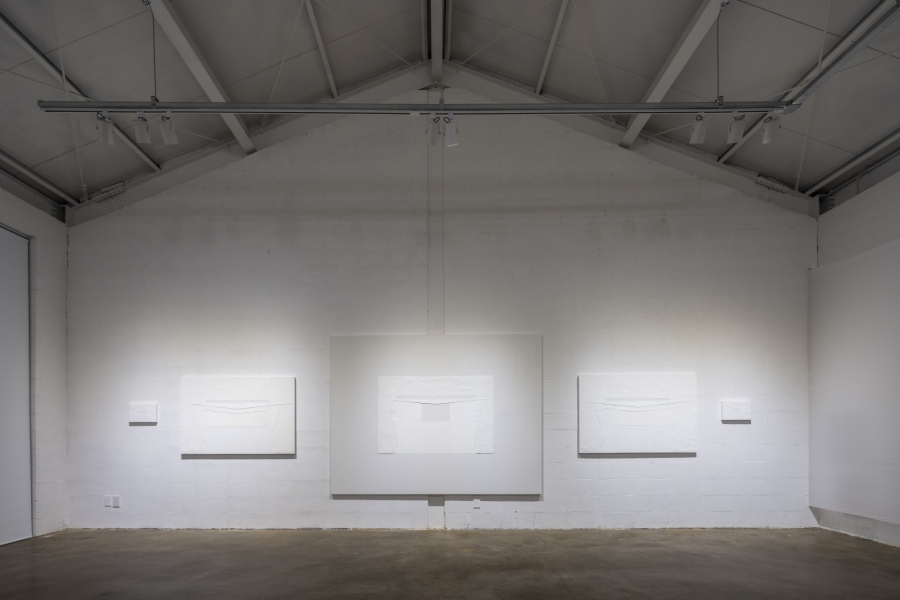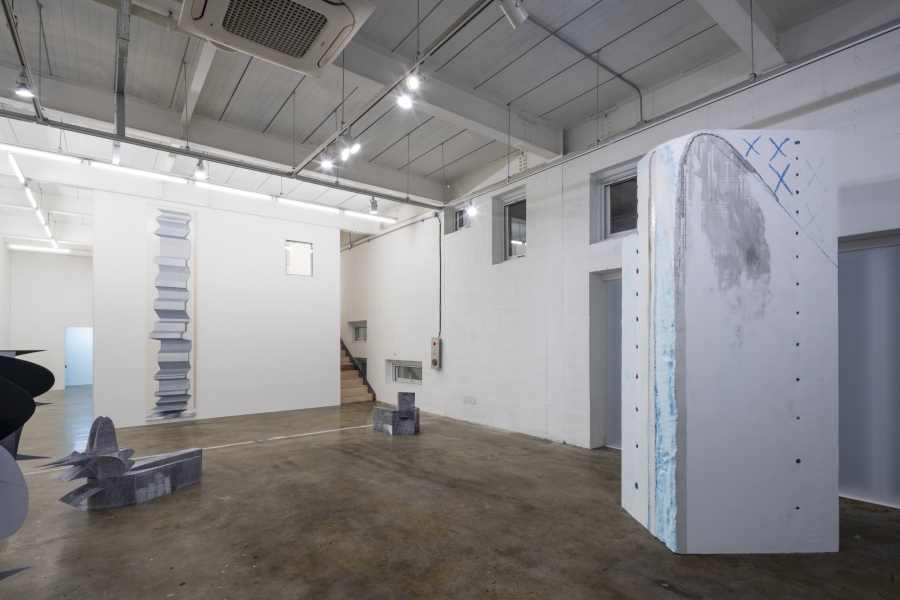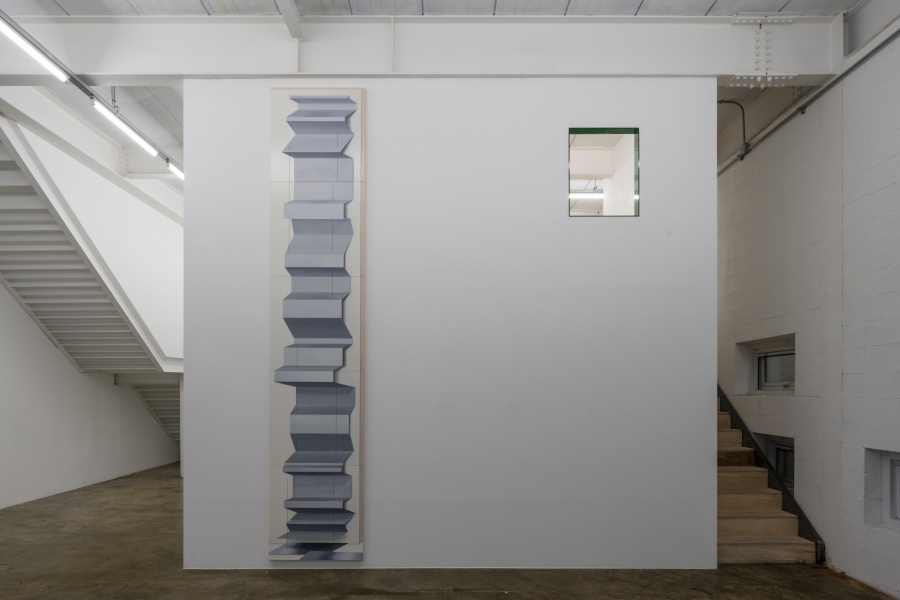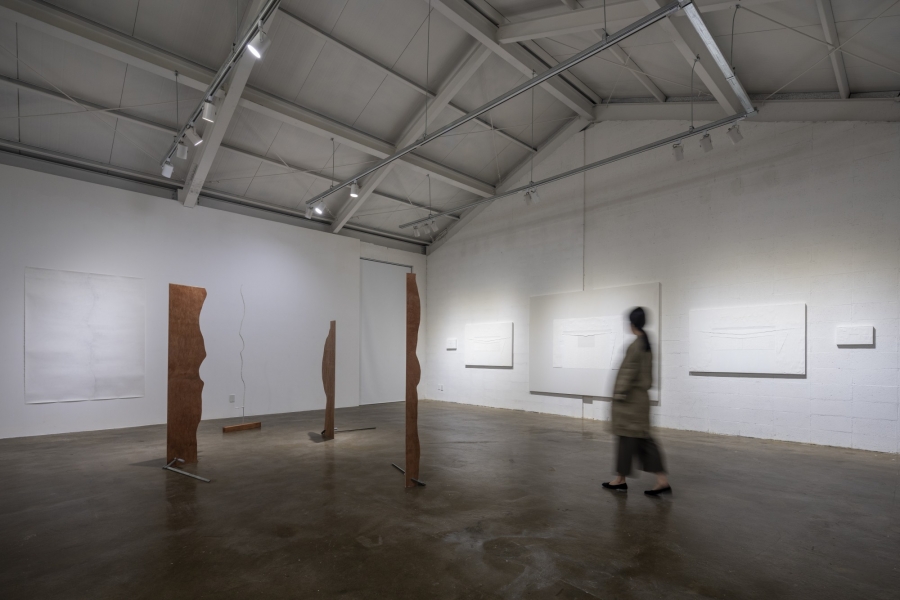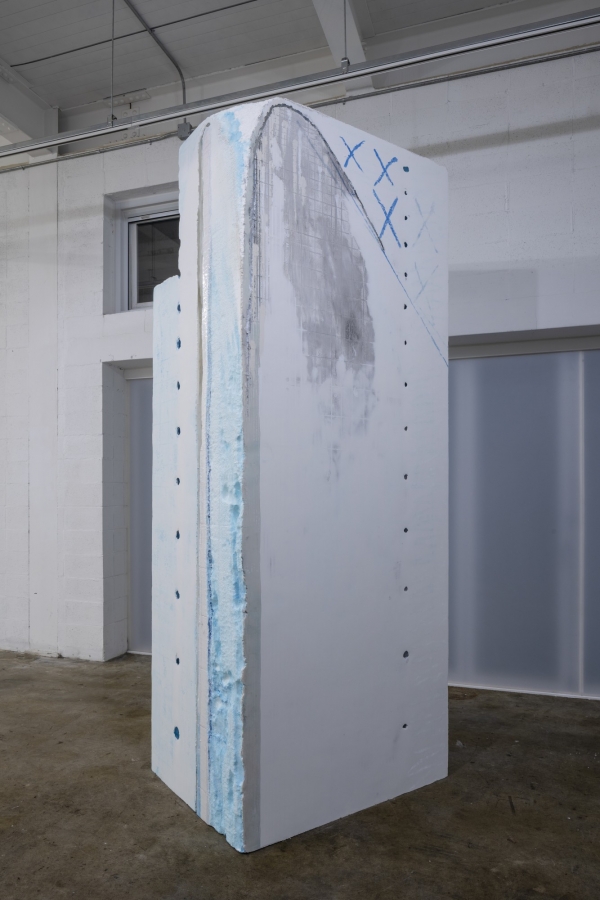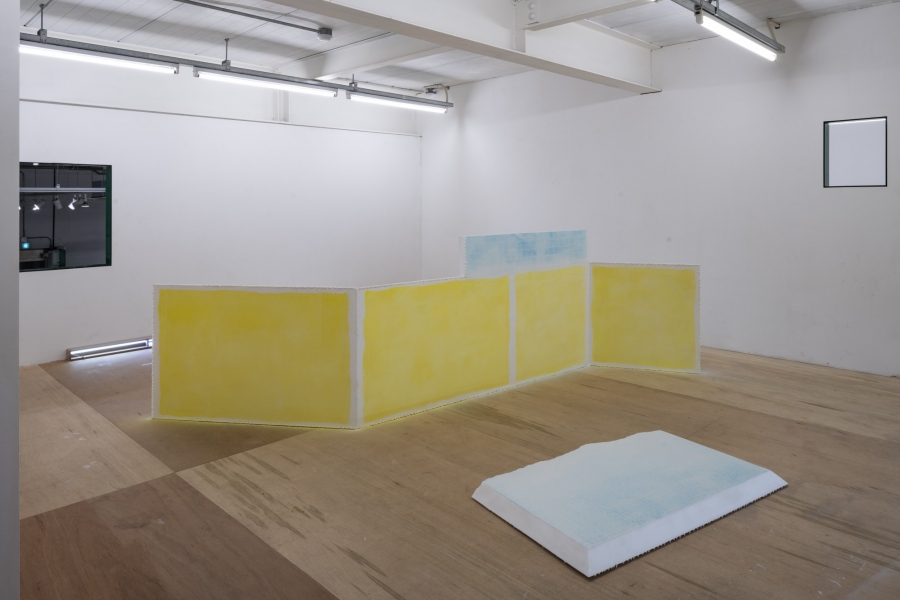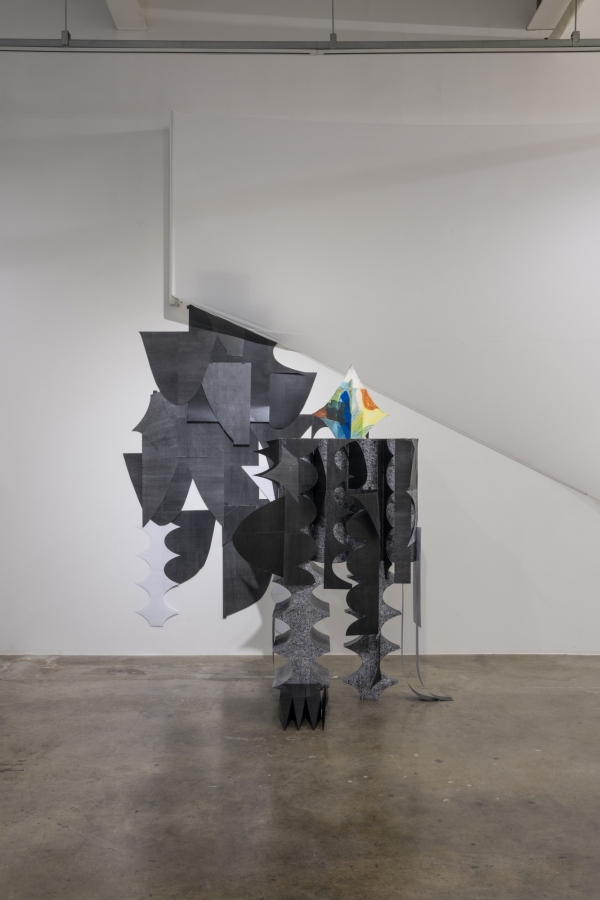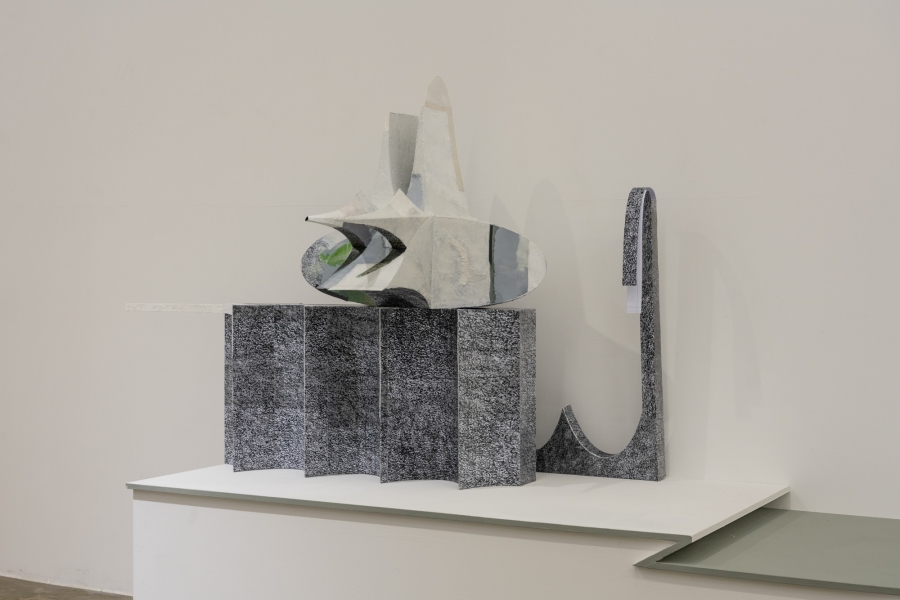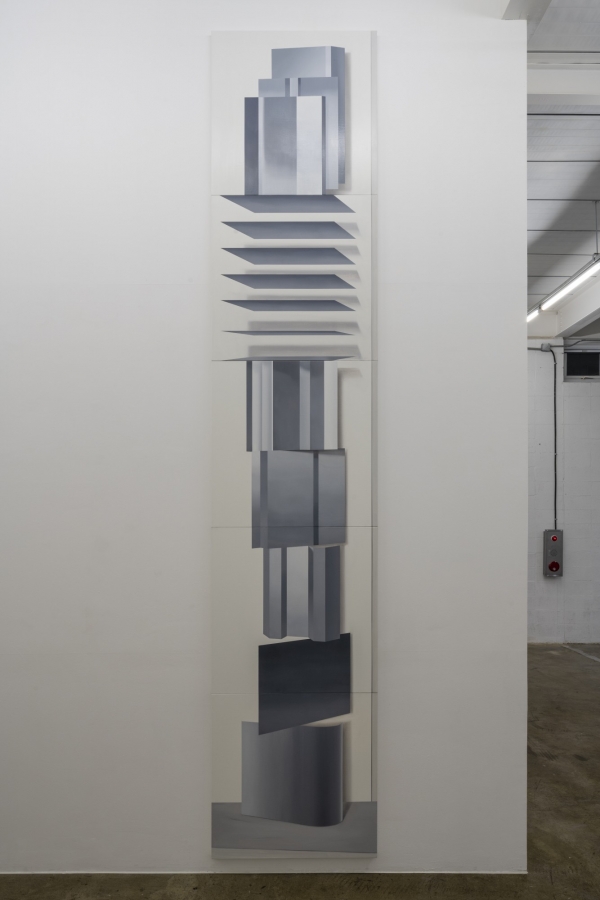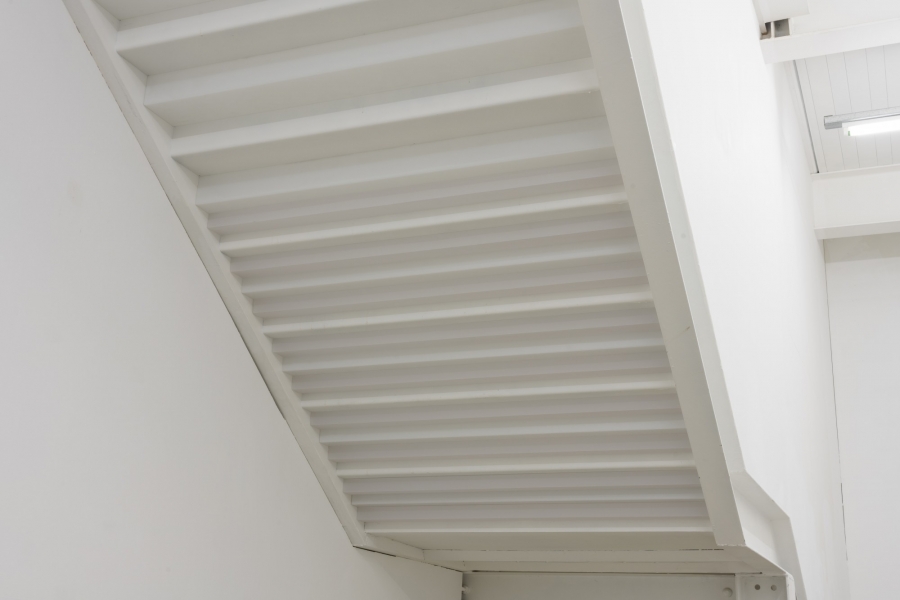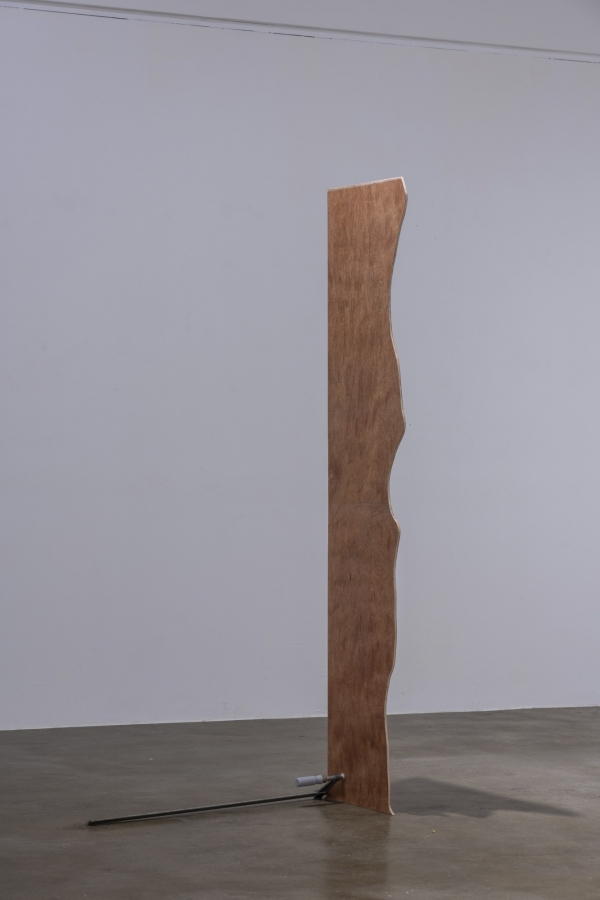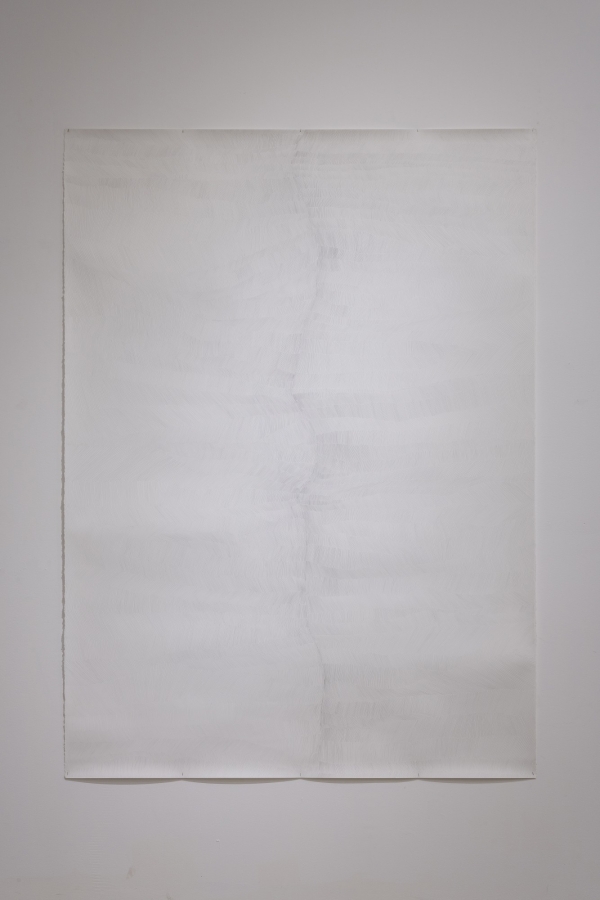정면성을 위하여: 사물의 규칙을 가로지르며
1
바실리 칸딘스키는 예술 연구에 있어서 가장 기본적인 문제는 작품을 구성하고 있는 예술요소(Kunstelemente)를 확인하는 것이라고 말한다. 그 중, 하나의 특수한 예술에서 작품을 위해 필수불가결한 요소는 기본요소(Grundelemente)이며 이는 부차적 요소(Nebenelemente)와 구분된다. 그리하여 칸딘스키가 점, 선, 면(Punkt und Linie zu Fläche에서 상정하는 회화의 두 가지 기본 요소는 점과 선이다. 그렇다면 면은 무엇인가? 칸딘스키가 여기서 면이라 일컫는 것은 예술 작품의 내용을 담는 물질적인 ‘기초평면’으로, 주변 환경과 구분되는 개별 영역이다. 그런데 이 책의 서문 마지막 부분에는 이러한 일반적인 정의에서 좀 더 밀고 나가 면에 관한 복잡한 역사를 구성해볼 수 있는 꽤나 흥미로운 언급이 나온다. 그 내용은 다음과 같다
…(중략) 이 얇은 책의 목적은 ‘그래픽’의 기본적인 요소들을 짚어보는 것이다.
1 ‘추상적’으로. 즉 물질적 면, 물질적 형식의 객관적 환경과는 거리를 두고.
2 물질적 면 위에서. 이 면이 지닌 근본적인 특성의 효과
그는 면을 회화를 구성하는 기본 요소로 분류하지는 않았지만 기본요소의 작용에 깊이 상관되어 있는 요소로서 본 것이다. 바꾸어 말하면, 면은 회화를 구성하는 요소들에 대한 일종의 매개변수(parameter)이며 그 요소들과 동등한 것이 아니라 그것들이 속해 있거나 전제되는 곳이다. 이는 칸딘스키가 반복해서 언급하듯 면이 언제나 질감을 지닌 재료로 이루어져 ‘물질적’이라는 사실에서 기인한다. 물론 칸딘스키는 면의 물질성에 대해 인정을 하면서도 그것에서 해방되는 것에 대해 상상했다. 조형요소들이 ‘둥둥 떠 있는’ 것으로 지각될 수 있는 면의 비물질화를 말이다. 그리고 그렇게 할 수 있기 위해서는 감상자의 고양된 능력이 필요하다고 보기도 하였다. 여하간 그는 결국 조형 요소들이 인간의 정신에 작용하는 바를 규칙화하려 했기 때문이다.
2
이러한 칸딘스키의 노력을 뒷받침할 수 있는 설득력 있는 실험은 회화의 영역 밖에서도 이루어졌다. 바로 한스 리히터, 발터 루트만, 비킹 에겔링 등에 의해 1920년대 독일에서 시작된 절대영화(Absolute Film)다. 이들은 영화라는 매체를 이용한 구체적 상(象)의 재현을 거부하고 순수한 추상적 요소들을 시청각적 체계의 시간-평면 안에 배치하였다. 그리고 과연 그것이 무엇을 전달할 수 있는지, 어떠한 감각을 생성하는지, 그것의 언어적인 기능이 무엇인지에 대해 질문했다. 물론 이들은 영화라는 매체의 조건을 적극적으로 이용하였기에 그 매체의 순수함에 가까이 다가서려는 것으로 읽힐 수도 있겠지만, 프로젝션 되는 이미지는 그 자체로 토대를 필요로 하지 않는 비물질적인 허상이라는 점에서 어쩌면 그들은 추상적 조형 요소의 정신적 작용을 탐구하는데 있어서 적절한 매체를 발견한 것인지도 모른다.1
3
칸딘스키가 맞닥뜨린 곤혹스러움, 즉 내용이 담보되는 작품의 평면이 물질적이라는 것은 기나긴 미술의 역사에서 무시되어온 사실이다. 미술은 그것이 종교적인 믿음에서 비롯되었든 사회·문화적 합의에서 비롯되었든 눈앞에 주어진 시각적 구성물의 환영적 요소를 강화해왔다. 누군가는 문명 이전의 사람들이 동굴 벽에 그려진 물소를 향해 창을 던졌을 거라는 추측하고, 우상 숭배를 위한 성상이 놓이는 장소는 종교적 숭고함의 체험을 통해 믿음을 강화시키는 고압적인 건축이다. 원근법의 시각성은 그 자체로 평면을 깊이감을 지닌 환영적 공간으로 만들었고, 대중들은 연출된 배경에서 연기하는 배우의 몸짓과 목소리가 흘러 나오는 영화를 관람하며 울고 웃는다. 환영은 그것이 놓여있는 바로 그 면의 존재를 간과하거나 무시해야만 강화되는 무언가였다. 그러나 오늘날 우리가 현대적 예술이라고 부르는 것들은 이러한 환영을 해체하는 것을 넘어 그러한 환영을 위한 조건 자체를 예술적 재료로 삼았으며, 종국에는 환영의 지지체를 장소에 귀속시키며 작품을 그때그때에 따르는 불확정적인 것으로 환원시킨다. 분명 이것은 미니멀리즘과 구조영화(Structural Film)뿐만 아니라 현대적인 음악과 무용 등 거의 모든 예술의 영역을 가로지르며 동시대 예술사의 특정한 순간에 등장한 실천일 것이다. 그러나 흩어져 사라진 것처럼 보이는 환영은, 교묘히 하나의 사물로 차디차게 스며든것처럼 보인다. 그 사물은 비미술과 미술, 미학과 사회, 풍경과 오브제, 내재적 의미와 체험의 감각, 그리고 현실과 그것을 초과하는 허구와 같은 어떤 경계들 사이를 배회하는 유령이 되었다. 오늘날 우리가 미술관 안에서 하나의 면을 본다는 것은 그리하여 물질적 지지체를 지각하는 것을 넘어 하나의 사물이 스스로에게 부여한 규칙을 감각하거나 체험하는 일이 되었고 그것이 자신의 규칙을 작동시킴으로써 우리에게 어떤 내기를 걸어오는지를 판단함으로써 미학적 충격의 길은 열린다.
4
로란린드 크라우스는 1960년대에 기존의 비평적 규준으로는 판단할 수 없는 조각 작품들이 쏟아져 나오자 이를 역사적으로 이해하기 위해 (모더니즘의 제한 조건들과 논리적으로 단절된)포스트모더니즘의 ‘확장된 장’을 상정한다. 이 확장된 장은 ‘부정성’을 통해 규범적인 정의에서 비롯되는 장르의 범주을 초과하고, 매체의 순수성을 우회하여 문화적 가치와 맞물림으로써 의미를 발생시키는 작품들의 운동 영역이다. 그리하여 이 확장된 장은 작품에 대한 비평적 논점이 작품을 구축하는 조건들에 대한, 그리고 그것이 관여하는 세계의 규칙에 대해 끊임없는 재배치를 수행하는 기능적인 것으로 전환되었음을 암시한다. 이 말은 한편으로 매체의 조건은 더 이상 절대적인 규범이 아니라 상대적인 상황으로 인지된다는 것을 뜻한다. 크라우스는 1950년대에 바넷 뉴먼이 한 말을 인용한다. “조각은 당신이 그림을 보려고 뒷걸음질 칠 때 마주치는 것이다.” 하나의 면은 회화도 아니고 조각도 아닌 부정성으로 획득되는 자리에 놓여있는 것임이 밝혀졌고, 그것은 이제 규칙의 총체 즉 개념적 텍스트가 산재한, 혹은 물질의 두께가 축적된 하나의 사물이 되었다. 바로 그것의 형식 안에서 우리는 리처드 세라가 작성한 기나긴 타동사의 목록과 같은 명령을 알아채야 한다. 여기서 ‘우리’는 단지 문법적 주어에 머무는 것이 아니라 ‘지금 여기’와 관련된 현상학적 주체이며, 이 주체는 규칙의 명령이 우리를 무엇으로 상정하는지 혹은 어떠한 주체로 호명하는지에 대해서 상상해야 한다. 오늘날 우리가 이해해야만 하는 면이라는 것은 바로 그러한 모종의 주체를 강하게 호명하는 사물이다.
5
그린버그는 화면 자체의 평면성이 회화의 유일무이한 순수한 요소라고 말하며 여타의 매체, 장르와는 구분되는 자기 정의를 입증하는 것이 모더니즘 미술의 기획임을 주장했다.2 물론 1960년 이후 후기 그린버그에게 평면성이란 캔버스의 물질적 조건이라기보다는 어떠한 환영적 공간도 연상시키지 않는 관람의 경험이다. 하지만 제스퍼 존스의 깃발(1954~1955)이나 과녁처럼 문화적 도상을 참조하고 회화를 하나의 이미지이자 오브제로 만든 작품들을 보면서 레오 스타인버그는 그와는 “다른 규준(Other Criteria)”이 필요함을 역설했다. 스타인버그에 따라 자연을 대상으로 참조하는 그림이 직립 자세에서 경험되는 감각을 연상시킨다는 측면에서 ‘수직적인 장’이라고 한다면, 새로운 평면은 문화적 참조물들이 켜켜이 조직되어 있는 평판(flatbed), 즉 수평적 장이다. 이는 미술의 주제에 있어서의 급진적인 전환이기도 하지만, 기존의 비평적 규준과는 다른 시각성을 요구한다는 점을 이해하는 것이 더 중요하다. 다른 시각성에의 요구는 다른 주체를 상정한다. 즉 회화에서 환영적 공간을 거세하고 순수한 평면을 판별해낼 수 있는 초월적 주체와 문화적인 재료들로 구조화된 삶의 양식을 지닌 주체는 구별된다.
6
재스퍼 존스의 ‘오브제로서의 회화’라는 측면은 즉물적인 사물을 작품으로 환원시킨 미니멀리즘에 영향을 준다. 로버트 모리스는조각에 대한 노트에서 다음과 같이 쓴다. “존스는 회화에서 배경을 없애 버렸고 그것을 고립시켰다. 배경은 벽이 됐다. 전에는 중립적이었던 것이 실제적인 것이 됐고 전에는 이미지였던 것이 하나의 사물이 됐다.”3 이보다 몇 해 전에 쓰여진 도널드 저드의 특수한 사물(Specific Objects)은 미니멀리즘이 회화와 조각 사이의 구분을 허물었다는 것이 골자였다. 즉 그것은 회화와 조각을 가로지르는, 선험적 구성이 중지된 ‘특수한 사물’로 오직 작품의 표면에 대한 경험만이 의미를 발생시킨다. 전시장 여기저기에 놓인 모리스의 육면체 빔은 공간을 자유롭게 거닐며 살펴볼 수 있었고, 그 관람의 시간동안 끊임없이 변화하는 표면에 대한 감각이 바로 작품이 제안하는 의미의 총합이었다. 하나의 평면이 말 그대로 물리적 공간 안의 사물로서 적극적으로 다루어지는 전환이다. 그러나 곧 이어진 미니멀리즘에 대한 반발은 그 사물들이 고갈되지 않는 기념비로 만들어졌으며, 또한 그것이 놓여 있는 시간과 공간과 제도를 너무나도 투명한 것으로 상상했고, 가장 중요하게는 불화 없는 확고부동한 1세계의 주류 시민을 지각의 주체로 상정했다는 것에서 기인한다. 매끈하고 밋밋한 표면의 단순한 구조물은 누구에게로 향하였으며 무엇을 요구하는가? 그리고 그것의 규칙에서 소외된 주체는 어떻게 망각되는가? 관계적 예술(Relational art)에서 매끈하게 봉합된 공동체는 바로 이러한 미니멀리즘의 현상학적 감각 주체의 쌍둥이들이며 산업적 재료의 표면이 덧씌워진 무한하고 일시적인 축적이라고 할 수 있을 것이다. 예술가들이 다루는 사물의 규칙은 그리하여 점점 더 사물을 둘러싼 세계의 조건과 관계 맺으며 복잡해진다. 그리고 아마도 고든 마타-클라크가 쪼개어 벌려 놓은 건축의 틈, 바로 그 단면은 그토록 난해하게 얽혀 있는 고르디아스의 매듭을 내려 친 흔적과도 같다.
7
여전히 미술이 세계를 향한 어떤 임무를 수행할 수 있다고 믿는다면, 오늘날 우리의 임무는 현상학적으로, 혹은 상상적으로 주어진 사물의 무한한 표면을 순진하게 감각하는 것을 넘어선다. 우리는 그 표면이 안내하는 규칙과 조건의 세계로 들어가야 한다. 그것을 인식하게 되었을 때 비로소 예술 작품이 무엇을 교란시키고 무엇에 대항하며 어떠한 간격을 통해 무엇을 재배치하는지에 대한 정치적 물음이 가능하게 될 것이다. 크라우스는 미니멀리즘의 산업적 재료와 ‘하나 다음에 또 하나’로 일컬어지는 수열적 배열의 형식이 소비자본주의의 생산 조건을 예비하고, 그것의 체험으로의 지향은 오늘날의 미술관을 지배하는 문화논리와 연결된다고 분석한다. 통시적 경험이 불가능한 강렬한 공간적 체험, 현실에의 몰입은 미니멀리즘의 단순한 표면에 이미 내재한 조건이었던 것이며, 그 논리는 우리의 행동과 사고를 역으로 규정한다. 이러한 역사적 통찰은 개별 작품에 대한 비평적 판단을 제공해줄 수는 없지만 비평적 판단을 위해 필요한 당대의 좌표가 어디인지, 그 토양의 성분은 무엇인지를 알려주는 유용한 자료가 된다. 어쨌든 당대의 작품을 마주한다는 것은 과도하게 확대되어 무엇인지 분간할 수 없는 대상을 장님처럼 더듬거릴 수 밖에 없는 일이지만, 그 더듬거림을 통해 굼뜨고 미세한 좌표이동이 이루어지기 때문이다.
8
오늘날 미술관에서 우리를 매혹시키고 또 우리의 감각과 사고방식에 스며있는 이데올로기와 친연성을 보여주는 것은 단연 영상일 것이다. 그 이유 중 하나는, 그것이 영상 기기의 기술적 진보로 인해 사물을 압도하는 거대한 환영적 평면을 우리에게 가뿐히 투사하기 때문이다. 그것은 무엇보다 강렬한 이미지의 현현이고, 대량 생산된 세속적 숭고이다. 하지만 더 중요한 이유는, 영상의 구조라는 것이 오늘날의 미디어 환경에 속한 보편적인 시민의 주체성을 구성하기 때문이다. 공간을 자율적으로 거닐며 미학적 충격을 상상하는 것이 지루해지고, 순차적으로 전환되는 가상의 시공간 편집기술에 더 익숙한 분열증적 주체 말이다. 그 편집의 언어는 근본적으로 의미의 의사소통을 초과하는 것으로, 서로 완전히 이질적이고 동떨어진 관계항들을 맞붙이며 하나의 구문론적 구조를 세우는 일이다. 무엇이 소통 불가능해 보이는 구문론적 구조를 그럴듯하게 봉합시키는 지는 끈질기게 놓지 말아야 할 질문이기도 하다. 그것은 당대를 압도하는 스펙터클에 대한 기억일수도 있지만, 한편으로는 오늘날 세계의 모든 유무형의 요소들을 집어 삼켜버린 자본이라는 실재적 허구의 장치에 대항할 수 있는 ‘세계 바깥의’ 서사 모델을 구성할 가능성이기도 하다. 적어도 영화를 재료로 삼는 대부분의 작품은 세계의 재구조화를 상상하며 세계 시민의 주체성을 변형시키려는 노력일 것이다.
9
멕시코 출신으로 1970년대에 네덜란드에서 활동한 개념미술가 울리세스 카리온에게 책이라는 매체는 ‘공간의 순차’로 정의된다. 그에게 책에 적힌 텍스트는 그리 중요하지 않으며, 오직 물질적인 지지체로서의 ‘책’이라는 형식만이 증명 가능한 실체다. 그는 북웍스 리비지티드라는 글에서 회화, 책, 신문, 사진, 필름/비디오 등 오늘날 우리가 문화적으로 사용하고 있는 대표적인 평면을 그것의 시공간적 특성과 감각의 방식에 따라 분류한다. 그리고 그러한 기능적인 측면으로의 접근은 음성 언어나 퍼포먼스와 같은 비물질적 매체의 논리에까지 다다른다. 카리온의 책은 일종의 재발명된 매체이다. 매체의 재발명은 그것이 구속시킨 이중의 논리를 변형시킨다. 하나는 그것의 제한 조건에서 산출된 형식이고, 다른 하나는 그 매체가 매개하는 사회적 합의이다. 카리온에게 있어서 책이라는 매체는 미학적 형식에 대한 ‘재고’를 가능하게 하는 매체였을 뿐만 아니라 하나의 사물이 관여하는 사회적 합의에 직접적으로 침투하고 개입할 수 있는 유용한 수단이었을 테다.4 책은 ‘독자’라는 주체를 상정하고, 이는 언제나 유통의 문제와 결부된다. 하나의 실재적 사물이 잠재되어 있는 ‘유통’이라는 허구적인 시공간은 그 사물이 기능할 수 있는 조건을 변형시키는 매개변수이고, 상상하는 주체성을 유동적인 상태로 머물게 하며, 그 자체로 사물의 허구를 강화시키는 틈이다. 이 유통의 문제는 디지털 환경이라는 당대의 전지구적 보편성을 고려했을 때 상당히 의미심장하다. 세스 프라이스는 확산을 마르셀 브로타스의 말을 인용하며 시작한다. “예술 활동의 정의는 유통의 영역에서 가장 먼저 발생한다.” 의미가 발생하는 형식, 혹은 장소로서의 유통은 어떤 시각성을 요구하는가? 은유적으로 말하자면, 그것은 벡터적이라기 보다는 스칼라적이고, 아카이브적이라기 보다는 데이터베이스적이다. 이것은 웹 세계의 규칙이었으나 이제는 우리의 물리적 공간의 구성 방식, 사고와 행동을 위한 지각의 범위를 규정하는 것으로 흘러넘치고 있다.
10
최근 몇 년 동안, 서울의 미술 현장에서는 새삼스러운 매체로의 회귀를 엿볼 수 있었다. 오늘날의 회화, 오늘날의 조각에 대해 질문하는 기획이 이어졌고, 퍼포먼스나 사진만을 모아 판매하는 유통 플랫폼이 큰 인기를 끌었으며, 영상만을 다루는 스크리닝 플랫폼이 급증했다. 이는 고도로 개념화되고 이론화되어 물적 토대 위에서의 교환이 묘연해진 미술에 대한 피로 혹은 거부이자, 이에 따르는 실존적인 작가 주체의 점진적인 소멸에 대한 반동처럼 보였다. 그리고 너무 성급하게 당도한, 혹은 자신의 세대의 의지와는 무관하게 수혈된 형식적 ‘콘템포러리’로부터의 역행처럼 보이기도 했다. 이것은 분명 서구 미술사의 진행과는 변별되는 교차로일지도 모른다. 그러나 이러한 움직임의 보수적인 측면은 매체의 이중구속, 즉 그것이 제한하는 형식과 그것이 관계 맺는 사회적 합의를 해체하고 매체적 조건의 재배치를 통해 일어나는 미학적 사건보다는 하나의 장을 확정하는 것에 더 몰두한다는 데 있다. 우리는 이제 더 이상 불안을 견딜 수 없게 된 것일까? 하지만 어쩌면 그것은 엉뚱하게 매개된 또 다른 환영주의일 것이다. 예술가가 매체에 특권적인 시대는 훌쩍 지나가 버렸음에도 불현듯 매체는 다시금 특권적인 것처럼 여겨진다. 하나의 장소는 자기 정의로 특정되면 특정될수록 바깥으로부터 배제되고 더욱더 고립될 뿐이다. 따라서 오늘날의 질문은 매체 자체에 있다기보다는 매체와 그것이 놓인 외부의 조건에 대한 함수에 있다. 우리에게 필요한 것은 매체들 사이를 가로지르는 대안적인 실천의 역사다. 그 역사는, 최근 우리가 분명히 경험할 수 있었던, 우리를 온갖 방향으로 또 아무 곳도 아닌 곳으로 널뛰게 만들었던 특정한 예술적 실천을 합당하게 이해하기 위해 요청되는 인식이기도 하다.
11
얼굴은 옆모습으로, 상체는 정면으로, 또 두 다리는 옆모습으로 새겨진 고대 이집트의 회화를 떠올려보자. 우리는 이러한 규칙이 적용된 예술적 프로그램을 정면성(frontality)이라는 개념을 통해 이해한다. 표면에 새겨진 이 비틀림은 초월적인 세계를 환기시키는 강력한 허구다. 곰브리치는 다음과 같이 말한다. “이 규칙을 엄격하게 준수하는 것은 아마도 그들의 마술적인 의도와 관계가 있는 것 같다. 왜냐하면 ‘원근법으로 단축되거나’ ‘잘려 나간’ 팔을 가진 사람에게 필요한 제물을 받거나 또 가져올 수 있을 것인가?” 오늘날의 예술에서 하나의 사물이 조형하는 정면성은 무엇인가? 그것은 우리에게 무엇을 요구하고 또 우리와 무엇을 교환하는가? 혹은, 그 규칙이 요청되는 세계의 조건은 무엇인가? 아마도 이제 더 이상 그것은 ‘마술적인 의도’와는 관계가 없을 것이다. 하지만 만약 사물의 규칙이 작동한다면, 그것이 펼쳐내 보이는 것은 일종의 마술적인 바깥의 세계임을 상상해본다. 그리고 앞선 질문들에 대해 꼼꼼히 대답해 나갈 때 비로소 그것의 정치에 대해 얘기해볼 수 있을 것이다.
1
Wassily Kandinsky states that the most fundamental problem in art studies is to identify Kunstelemente (art elements) which constitutes a body of artwork. The indispensable basic elements of each particular art work is Grundelemente and it is separated from Nebenelemente (secondary elements). Hence, he suggests that “points and lines” are two basic elements of painting in Punkt und Linie zu Fläche. Then, what is the plane here? The plane called by Kandinsky here is the material plane which is called upon to receive the content of the work of art as being distinguished from the surrounding environment. Yet, there is a fairly interesting state at the end of the introduction of the book in respect to considering a history of plane for pushing further than the general definition. It reads as follows.
… The aim of this small book is merely to point out, in a general and fundamental way, the ‘graphic’ basic elements viewed:
1 ‘abstractly’ i.e. isolated from the objective environment of the material form of the material plane, and
2 on the material plane – the effect of the fundamental characteristics of the plane.
Although he did not classify a plane as a basic element of painting, he regarded it is deeply related to how the basic elements work as an element. In other words, the plane is where the consisting elements of painting belong to or presuppose as a parameter to them albeit it is not equivalent to them. This is resulted from the fact that, as Kandinsky repeatedly mentioned, the plane is always material made of textured materials. Of course, Kandinsky acknowledged the materiality of the plane, but also imagined to be liberated from it at the same time. That is to say the dematerialization of the plane that can be perceived as formative elements are ‘floating’. And for the liberation, he thought that the enhanced ability of viewers is necessary. At any rate, he ultimately tried to rule the way how formative elements function in the human mind.
2
The persuasive experiments supporting Kandinsky’s efforts were also done outside of the scope of painting. It was the genre of Absolute Film, which had been started in Germany in the 1920s by Hans Richter, Walter Ruttmann, Viking Eggeling and others. They had refused to represent the reified images through the medium of film and disposed unalloyed abstract elements in the time-plane of the audio-visual system instead. Thereby, they had asked what it could convey, what kind of sense it could generate, and what its linguistic functions were. Due to they had actively used the conditions of the film medium, they may be read as trying to get closer to the innocence of the media. However, in a regard, the projected image is an immaterial illusion that does not require a foundation for itself, perhaps they had founda suitable medium for exploring the spiritual functions of abstract formative elements.1
3
The predicament in front of Kandinsky, i.e., the fact that the plane of an artwork with unobliterated contents is material, had been ignored in the long history of art. Whether it comes from religious beliefs or social and cultural consensus, art has strengthened the illusionary elements of the given visual components. Some conjecture that the pre-civilized people would throw a spear at the water buffalo in the cave mural, and the place for the idolatry is a high-pressure structure that strengthens faith through the experience of religious sublime. The visibility of the perspective has made a plane as an illusionary space with a sense of depth, and audiences cry and laugh while watching the actors’ gestures and voices in movies which were filmed in fabricated backgrounds. The illusion was something that could be consolidated only if we neglect or ignore the existence of the plane where it is placed. But, what we call modern arts today, have adopted the condition for the illusion as an artistic material beyond dismantling the illusion and eventually attributed the support of the illusion to the place for revivifying artworks to the indefinite things which are following each occasion. Obviously this is a practice that emerges at a particular moment in history of almost all areas of contemporary art including modern music and dance, not merely Minimalism and Structural Film. But the illusion, which is considered as has been being dissipated and disappeared, seems to be insidiously ingratiated with a single object. The object became a ghost wandering between certain boundaries, such as non-art and art, aesthetics and society, landscapes and objects, senses of intrinsic meaning and experience, and reality and fictions. To see a plane in the museum today has become certain activities of us to experience and sense the rules that an object has given to itself beyond only to perceive a material support. Furthermore, the path of aesthetic shock opens as we grasp what wager the plane is betting on us by activating its own rules.
4
In the 1960s, when sculptural works which could not be judged by existing criterion norms were poured out, Rosalind E. Krauss has presumed the “Expanded Field” of Postmodernism (logically disconnected from the Modern- ism’s constraints) in order to understand the works with the historical context. The Expanded Field is the exercise area of the works that generates the meaning through engaging with cultural value as bypassing the purity of the medium as well as transcending the category of genre which comes from the normative definition through “negativity”. Thus, this Expanded Field implies that the critical point of view on artworks has been transformed into a functional one which constantly relocates the conditions of qualifying artworks and the rules of the world to which it relates. On the one hand, it means, that the conditions of the medium are no longer perceived as absolute norms, but perceived as relative situations. Krauss quotes Barnett Newman’s remarks in the 1950s. “Sculpture is what you bump into when you back up to see a painting.” It has been ascertained that a plane is in between position acquired by negativity neither painting nor sculpture. And now the plane has become a totality of rules with scattered conceptual text or a thing made of accumu- lated thickness of materials. In its form, we should realize the command identical to the list of long transitive verbs written by Richard Serra. The “we” in the context, are not just a stagnant grammatical subject, but a phenomenological subject associated with ‘here now’, and this subject should imagine what the command of the rule postulates us to be or calls us as which subject. The plane what we have to understand today is the thing that intensely calls out such a certain subject.
5
Clement Greenberg argued that flatness alone is unique and exclusive to pictorial art, and what has to be exhibited and made under the context of Modernism is what could determine explicit self-definition through proving own exclusiveness distinguishable from other medium and genre.2 Of course, for Greenberg post-1960, flatness is an experience of viewing that does not remind viewers of any illusionary space, rather than the material conditions of the canvas. However, Leo Steinberg claimed the necessity of “Other Criteria” which is dissociated from such works that reference to cultural icons and turn them into pictorial images or objects as Jasper Johns’s Flag (1954~1955) and Target (1958). According to Steinberg’s argument, if a painting referring to nature is a ‘vertical field’ in terms of it is reminiscent of a sense of experience in an upright posture, the new plane is a horizontal filed so-called flatbed in which cultural references are piled up. It is important to understand that this radical shift in the subject of art requires a different visibility unlike what the existing critical norm used to. The demand for different visibility presumes another subjects. In other words, there is a distinction between the transcendent subjects capable of distinguishing pure planes from the illusionary space in paintings, and the subjects with the forms of life structured with cultural mate- rials.
6
The aspect of “painting as an object” of Jasper Johns’s affects Minimalism that has reduced a realistic object to an art piece. Robert Morris wrote in Notes on Sculpture: “Johns took the background out of painting and isolated the thing. The background became the wall. What was previously neutral be-came actual, while what was previously an image became a thing.”3 The kernel of Specific Objects written by Donald Judd a few years earlier, was that Minimalism demolished the distinction between painting and sculpture. In other words, this ‘specific objects’ which is traversing between painting and sculpture and which a priori composition is not allowed, generates meaning only with an experience of the surface of work. Morris’s hexahedral beams were located all over the exhibition room and people were able to walk around them freely. It was the ensemble of proposed meaning by the work that is sensing the perpetual changing of surface during the entire time of the viewing. It was the transition that one plane is actively treated as an object literally in physical space. However, the immediate repulsion on Minimalism originated from the facts that the objects has been designed as monuments that are not depleted, the Minimalists considered the time, space and institution for presenting the objects as so transparent, and most importantly, they have postulated the impregnable mainstream citizens of the world as the subject of perception. What is the minimalized structure of glary and flat surface headed to whom and what does it request to them? How the oblivious entities alienated by the rules are forgotten? The community that was seamlessly formed in relational art can be said as a clone of this phenomenological sensory subject of Minimalism, also an infinite and temporary accumulation of the overlaid surfaces of industrial materials. Thus, the rules of things dealt with by artists become increasingly more complicated as relating to the conditions of the surrounding world. And the section of the cleft in the architecture that has been cracked up by Gordon Mata-Clark, is like a trail of stroking down the intricately intertwined Gordian knots.
7
If we still believe that art can carry out some missions for the world, our task of today is beyond naively sensing the infinite surface of a phenomenologically or imaginatively given object. We must enter the world of laws and conditions that the surface guides. Then we could be able to ask political questions about what artworks are resisting, disturbing and rearranging at which intervals, only after we come to recognizing the task. R. Krauss analyzes that Minimalism’s industrial materials and the form of continual arrangement so-called ‘one thing after another’, prepare the conditions of production in consumer capitalism and the pursuit of experiencing them is linked to the cultural logic which dominates museums of the day. The immersion into reality and the intense spatial experience which paralyzes diachronic experience, are the conditions that were already inherent in the simple surface of works in Minimalism, and that logic inversely defines our actions and thoughts. Even if these historical insights could not provide a critical judgment of individual work, they are useful data that tell us where as well as the necessary coordinates for critical judgment of the time and what constitutes the ground. It is an inevitable fact that facing the artwork of the day is like fumbling with an indistinguishable overextended thing as a blind, yet, the fine and slow movement of the coordinates is happened by the fumbling.
8
It must be a moving image that is showing the ideology and affinity which permeates our senses and thoughts also fascinates us in today’s museums. One reason for this is that it can effortlessly project a gigantic illusionary plane which overwhelms objects with technological advances in video equipment. It is the manifestation of the most powerful image more than anything else and secular nobility in mass production. Yet, more importantly, the structure of the moving image constitutes a universal citizen’s subject- hood belonging to media environment of present day. It is a schizophrenic subject who is more familiar with sequentially transformable virtual space-time editing techniques and has become being bored to imagine aesthetic shocks could be experienced as liberally walk around the space.
The language of the editing is basically beyond communication of meaning, so it is making a syntactic structure as setting relational clauses opposite each other which are completely irrelevant and heterogeneous. Yet, in this respect, it has to be a persistent question thinking of what makes the syntactic structure which seems to be impossible to communicate is plausibly joined. Perhaps it would be a memory of the spectacles which overwhelm the contemporary, but on the other hand, it can be the possibility of constructing a “world outside” narrative model for resisting the realistic fictional device so-called capital that has swallowed all the inimitable elements of the world today. If nothing else, almost the video art pieces are in a bid to transform the subjectivity of global citizens as imagining
the restructure of the world.
9
A medium of books is defined as ‘the sequence of spaces’ by Ulises Carrión, a Mexican conceptual artist worked in the Netherlands in the 1970s. To him, text written in a book is not so important, only the form of a ‘book’ is a provable reality as a material support. In his publication Bookworks Revisited, he categorizes representative planes that we culturally use today such as paintings, books, newspapers, photographs, and films/videos, according to their distinctive temporal and spatial characteristics and the ways to sense each of them. This approach to such functional aspects reaches to the logic of immaterial media like phonetic language or performance. Carrión’s book is a kind of re-invented medium. The reinvention of the medium trans-e forms the double logic it has restrained. One is the form produced in its restrictive condition, and the other is the social consensus mediated by the medium. For Carrión, a book as a media was not only a medium that enabled the ‘rethinking’ of aesthetic forms, but also a useful mean of directly penetrating and intervening in the social consensus involved in one thing.4 A book postulates the subject of ‘reader’, and it is always associated with the problem of distribution. “Distribution” is a fictitious time and space in which one real object is latent. It keeps the imaginative subjectivity in a fluid state and it is a parameter that trans- forms the conditions which the object can function under it, also concurrently a crack strengthens the fiction of things by itself. The problem of this distribution is quite signifi- cant considering the global universality of the current digital environment. Seth Price begins the essay Dispersion with a quote of Marcel Broodthaers. “The definition of artistic activity occurs, first of all, in the field of distribution.” What kind of visuality does the distribution in which the form or the place for generating meaning, require? Metaphorically speaking, it is more of a scalar than a vector, and more of a database rather than an archive. This used to be the rule of the web world, however now the rule is overflowing with the way of composing our physical space, and defining the range of our perception engaging in our thoughts and actions.
10
In recent years, it has been able to get a glimpse of the renewed return to the media in the art scene in Seoul. Questions on painting or sculpture of today have been given out in several discursive exhibitions, some platforms for distributing performance pieces and photographs only has gained popularity, and the screening platforms merely dealing with moving image works have been proliferated. These tendencies seemed to be a signal of fatigue or a rejection of the high conceptualized and theorized art which physical exchange is almost impossible, or seemed to be a recoil to the gradual disappearance of the subjects of existentialism artists. Also it looked as if a retrograde step from the empty “contemporary art” which had been transferred irrespon- sibly or transfused regardless of the will of the generation. Perhaps, it could be the intersection that is distinguished from the progress direction of Western art history. Yet, in effect, the conservative aspect of such movements is the double constraint of the medium, in the other word, it is more engrossed in taking up a field in the art world rather than scrutinizing the aesthetic matters that occur through the process of relocating the conditions of medium as well as disassembling the social consensus and restricted form. Have we become no longer could bear anxiety any further? It might be another illusionism that was meddled irrelevantly. Suddenly the medium is again considered as privileged, even if the era of artists were prerogative to the media had far passed away. The more a single place is specified by self-definition, the more excluded and more isolated from the outside. Therefore, today’s question is not in the medium itself, but in a function in between the medium and the external conditions where the medium lies. What we need is a history of alternative practice transverse media. The history, what we certainly have experienced in recent, is the awareness required to understand properly the specific art practices that have made us to desultorily wander around to every direction even to nothing.
11
Let’s bring to mind the characters in Ancient Egyptian painting which are drawn in profile, while the body is seen from the front and the legs are turned to the same side as the head. We understand the artistic program which those drawing rules are applied, based on the concept of frontality. The distortion of the character carved on the surface is a powerful fiction that evokes a transcendent world. E. Gombrich mentioned, “Perhaps this strict adherence to the rule had something to do with their magic purpose. For how could a man with his arm ‘foreshortened’ or ‘cut off’ bring or receive the required offerings to the dead?” What is the frontality formulated by a single object in today’s art? What does it require of us and what does it exchange with us? Or, what are the conditions of the world in which the rules are requested? It is conceivably no longer relevant to ‘the magic purpose’. Nonetheless, if the rules of objects work, a sort of magical outside world would be the consequence of it. And we will be finally able to talk about its politics only when we answer to the earlier questions thoroughly.
-
실제로 리히터의 Rhythmus 21(1923), 루트만의 “Opus” 시리즈(1921~1925), 에겔링의 Symphonie Diagonale(1921) 등 절대영화를 대표하는 대부분의 작품의 배경은 검은색이다. 어둠이 영화를 관람하는 중요한 조건이라면, 검은 배경은 어둠과 동화되고 화면 안에서 움직이는 빛의 조형적 움직임은 평면을 벗어나 매우 입체적으로(마치 유령처럼), 또 선명하게 감각되었을 것이다. 이미지의 환영성을 증폭시키는 장치로서의 검은 바탕에 대한 고고학적인 접근에 관해서는 다음을 참고하라. Noam M. Elcott, Artificial Darkness: An Obscure History of Modern Art and Media(Chicago, IL: University of Chicago Press, 2016).
In fact, the backgrounds of most works representing absolute films are black, such as Hans Richter’s Rhythmus 21 (1923), Walter Ruttmann’s Opus series (1921-1925), and Viking Eggeling’s Symphonie Diagonale (1921). If darkness was an important condition for watching a movie, the black background would be assimilated with darkness, and the movement of light in the screen would be very stereoscopic (as a ghost) and vividly sensed beyond planarity. For an archeological approach to the black background as a device that amplifies the illusionism of images, see: Noam M. Elcott, Artificial Darkness: An Obscure History of Modern Art and Media, Chicago, IL: University of Chicago Press, 2016. ↩ ↩ -
“사실주의적인, 즉 환영주의적인 미술은 매체를 숨기면서 미술을 은폐하기 위해 미술을 사용했었다. 그러나 모더니즘은 미술에 주의를 집중시키기 위해 미술을 사용했다. 회화의 매체를 구성하는 여러 한계들 – 평평한 표면, 그림 바탕의 형태, 안료의 속성 – 은 과거의 거장들에 의해 오직 암묵적으로나 간접적으로밖에는 인정될 수 없는 부정적인 요소로 취급되었다. 반면 모더니즘 회화는 이 똑같은 한계를 공공연하게 인정될 수 있는 긍정적인 요소들로 간주하게 되었다.” 클레멘트 그린버그, 조주연 옮김, 모더니즘 회화(1960), 예술과 문화, 경성대학교 출판부, 2004.
“Realistic, illusionist art had dissembled the medium, using art to conceal art. Modernism used art to call attention to art. The limitations that constitute the medium of painting - the flat surface, the shape of the support, the properties of pigment - were treated by the Old Masters as negative factors that could be acknowledged only implicitly or indirectly. Modernist painting has come to regard these same limitations as positive factors that are to be acknowledged openly.” Greenberg, Clement. “Modernist Painting”, in Art and Culture translated by Cho, Joo Yeon, Kyungsung University Press, 2004. ↩ ↩ -
할 포스터 외 지음, 신정훈 외 옮김, 1900년 이후의 미술사, 세미콜론, 455쪽에서 재인용.
Foster, Hal et al, Art Since 1900, translated by Shin, Jeong Hun et al, semicolon, 2016: 455. ↩ ↩ -
카리온은 1975년부터 1978년까지 서점이자 갤러리인 “아더 북스 앤 소(Other Books and So)”를 직접 운영했다.
From 1975 to 1978, Carrión ran the bookstore and gallery “Other Books and So”. ↩ ↩
